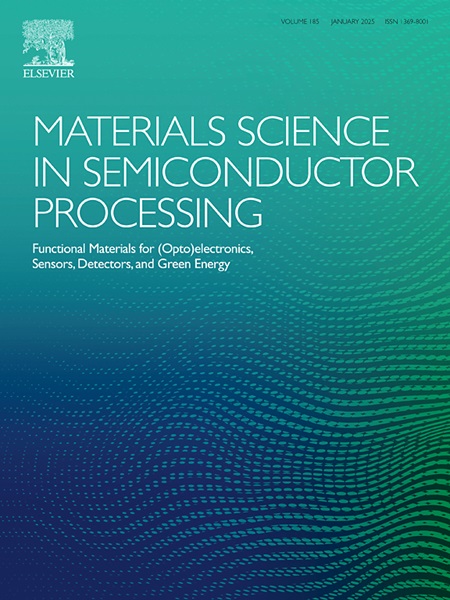Tuning of electrical properties and persistent photoconductivity of SnO2 thin films via La doping for optical memory applications
IF 4.2
3区 工程技术
Q2 ENGINEERING, ELECTRICAL & ELECTRONIC
引用次数: 0
Abstract
This work explored the potential of utilizing Lanthanum doped tin oxide Sn1−xLaxO2 (x = 0.01 to 0.1) based Metal-Semiconductor-Metal Ohmic photoconductors for optical memory applications making use of the persistent photoconductivity (PPC) property. The structural, optical, and electrical properties of Sn1−xLaxO2 thin films deposited on glass substrates using the spray pyrolysis method, with a focus on the impact of lanthanum concentration on the photoresponse characteristics was investigated. Raman spectroscopy confirmed the presence of oxygen vacancies and nanometric grain size in the films along with the typical Raman active modes of tin oxide. The Sn4+ and La3+ oxidation states in Sn1−xLaxO2 as well as the contributions from lattice oxygen and oxygen vacancies were identified using XPS. Photoluminescence studies revealed emissions in the UV, violet, blue, and yellow regions, corresponding to tin interstitials, oxygen vacancies, and other defects, with intensity variations based on La concentration. All films exhibited n-type conductivity, with La content influencing both resistivity and carrier concentration. Photoconductivity measurements demonstrated enhanced photocurrent under UV illumination, with La doping affecting energy levels and defect states. The Sn0.90La0.10O2 film possessed a photocurrent retention of nearly 64 % within a span of 104 s, showing that higher concentration of La favoured the enhancement of retention of photocurrent for a comparatively longer duration. The significant persistent photoconductivity requires the conditions like optically active materials, a built-in electric field to separate electron-hole pairs, and defect states to trap carriers, which are all met by the prepared Sn1-xLaxO2 photoconductor with higher La doping levels, confirming the suitability of these films for practical use as optical non-volatile memory elements.
通过掺杂 La 调节 SnO2 薄膜的电学特性和持久光电导性以实现光存储应用
这项研究探索了基于金属半导体-金属欧姆光电导体的掺镧氧化锡 Sn1-xLaxO2(x = 0.01 至 0.1)在光存储应用中利用持久光电导(PPC)特性的潜力。研究人员采用喷雾热解方法研究了沉积在玻璃基底上的 Sn1-xLaxO2 薄膜的结构、光学和电学特性,重点研究了镧浓度对光响应特性的影响。拉曼光谱证实了薄膜中存在氧空位和纳米粒度,以及典型的氧化锡拉曼活性模式。利用 XPS 确定了 Sn1-xLaxO2 中的 Sn4+ 和 La3+ 氧化态,以及晶格氧和氧空位的贡献。光致发光研究揭示了紫外、紫光、蓝光和黄光区域的辐射,这些辐射与锡间隙、氧空位和其他缺陷相对应,其强度随 La 浓度的变化而变化。所有薄膜都表现出 n 型导电性,而 La 的含量会影响电阻率和载流子浓度。光导率测量结果表明,在紫外线照射下光电流增强,掺入 La 会影响能级和缺陷状态。在 104 秒的时间跨度内,Sn0.90La0.10O2 薄膜的光电流保持率接近 64%,这表明较高浓度的 La 有利于延长光电流的保持时间。显著的持续光电导能力需要光学活性材料、分离电子-空穴对的内置电场和捕获载流子的缺陷态等条件,而掺杂较高 La 的 Sn1-xLaxO2 光电导体均满足这些条件,这证实了这些薄膜适合作为光学非易失性存储器元件实际使用。
本文章由计算机程序翻译,如有差异,请以英文原文为准。
求助全文
约1分钟内获得全文
求助全文
来源期刊

Materials Science in Semiconductor Processing
工程技术-材料科学:综合
CiteScore
8.00
自引率
4.90%
发文量
780
审稿时长
42 days
期刊介绍:
Materials Science in Semiconductor Processing provides a unique forum for the discussion of novel processing, applications and theoretical studies of functional materials and devices for (opto)electronics, sensors, detectors, biotechnology and green energy.
Each issue will aim to provide a snapshot of current insights, new achievements, breakthroughs and future trends in such diverse fields as microelectronics, energy conversion and storage, communications, biotechnology, (photo)catalysis, nano- and thin-film technology, hybrid and composite materials, chemical processing, vapor-phase deposition, device fabrication, and modelling, which are the backbone of advanced semiconductor processing and applications.
Coverage will include: advanced lithography for submicron devices; etching and related topics; ion implantation; damage evolution and related issues; plasma and thermal CVD; rapid thermal processing; advanced metallization and interconnect schemes; thin dielectric layers, oxidation; sol-gel processing; chemical bath and (electro)chemical deposition; compound semiconductor processing; new non-oxide materials and their applications; (macro)molecular and hybrid materials; molecular dynamics, ab-initio methods, Monte Carlo, etc.; new materials and processes for discrete and integrated circuits; magnetic materials and spintronics; heterostructures and quantum devices; engineering of the electrical and optical properties of semiconductors; crystal growth mechanisms; reliability, defect density, intrinsic impurities and defects.
 求助内容:
求助内容: 应助结果提醒方式:
应助结果提醒方式:


